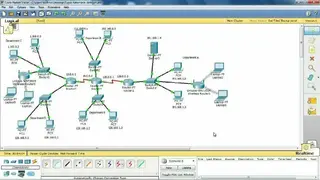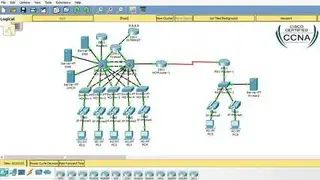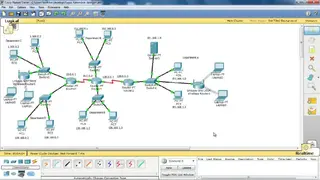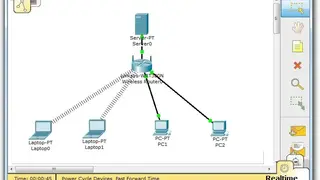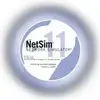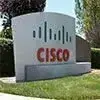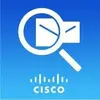
Cisco Packet Tracer
Cisco Packet Tracer is a software and visual simulation tool that allows users to create network topologies and replicate modern computer networks. By practicing a command-line interface, it will enable the users to configure Cisco routers and switches.
It can work on operating systems like Linux, android 4.2, MS Windows, and iOS 8, etc. It provides visualization, simulation, authoring, evaluation, and association competencies to facilitate teaching and learning of different complicated technology concepts.
The simulation model can provide tables, diagrams, and other visual representations of dynamic data transfer and the development of packet content. By using real-time visuals, users can replace the whiteboards and fixed slides and can decrease presentation time.
One of the prominent features is that it has two workspaces. The logical workspace allows the users to build logical network topologies by connecting network devices, and the physical workspace provides a graphical and physical aspect of the logical network.
Cisco Packet Tracer Alternatives
#1 Virtual PC Simulator
Virtual PC Simulator is an open-source software running on Linux and Windows, where only limited network commands can be used. It is an ideal tool to use in simulated networks such as GNS3 as it has developed from a simple to a robust testing ACLs tool. Because of the detailed output of ping replies and commands such as to see packet dumps, etc., made it a toolkit for the networking engineers.
Virtual PC Simulator simulates up to 9 PCs, and it is more useful than traditional PCs because it can send and receive UDP and TCP pings. From the virtual PCs, you can ping or trace out the other routers or hosts when you learn the Cisco routers in the Dynamips. It can substitute the routers or VMware boxes used as PCs in the Dynamips network.
When it starts, it attends the ports from 2000 to 2008 and delays the dynamips to connect and sends the packets to the ports from 3000 to 3008, which would be accompanied by the dynamips.
#2 Router Configuration Generator Tool
Router Configuration Generator is an open-source application to use as an extension for GNS3 that spontaneously creates the configuration of all Cisco network equipment, which is part of the virtual topology. Through topology setup configuration files produced by GNS3 provides nodes like switches and routers without opening their matching consoles.
It provides you a standard that which configuration should be applied as it includes customized settings such as the routing protocol etc. To integrate with GNS3 and to run this tool, there are two requirements to work with this application on Windows that is GNS3 (latest version) sources files and the Latest version of rcg-tool.
You can generate a tool menu button by following two easy steps that also include gns3-GUI (main_window.py). Before constructing GNS3’s GUI, it will ask you to make some changes in the folders that need to be done, after which the GNS3 should build good and run rcg-tool.
#3 Free SNMP Agent Simulator
Free SNMP Agent Simulator creates a network of up to 100000 SNMP manageable devices on one server. The users can simulate any SNMP centered device with any of the public or private MIBs to run an enormous range of devices configurations with their SNMP management application. It lets users create thousands of traps to simulate disaster states.
SNMP feature includes multiple agents in one box, customized SNMP agent simulation, SNMP agent instance configuration, and extensible environment. It also offers real-time modifiable simulations, configurable SNMP Trap Generation, and recording environment.
SNMP gives a response to MIMIC simulated devices. Each device has its IP address, and the tools can be organized at run-time both on a single and shared basis. The MIMIC discovery wizard can record the production network of users with thousands of real-life devices to simulate them and increase many times. It can accumulate any number of SNMP MIBs at the same time in any order. The Windows, Solaris, Linux, and Amazon cloud are the supported platforms.
#4 Live Raizo – Linux Distro for Networks
Live Raizo is open-source software and a live distribution based on a virtual Linux machine called Debian that comprises various network tools and services. It also includes tools to interrelate with real devices such as Wireshark and minicom, as well as SSH, HTTP, and TFTP servers.
Its core features allow you to build a complex virtual network with drag and drop options. You can link with hubs or switches and utilize server or router as a client because you have simulated machines based upon Debian. You can introduce your OS if it is compatible with Linux, Microsoft, and ASA Firewall. You can connect your simulated network with the physical system using drag and drop options.
Many network tools are already available on Debian VMS, and it allows you to install tools you need like Linux / Debian, etc. You can also modify LiveRaizo with remote scripts that emerged on a server. A minimal window manager increases the memory of the CPU for the virtualization.
#5 NetSim
NetSim is a software, an end-to-end packet level, full-stack, emulator, and simulator. It provides the network engineers a technology development atmosphere for protocol monitoring, network research and development, and military communications.
NetSim Pro version is suitable for commercial enterprise customers and the NetSim standard, and NetSim Academic targets at education customers. Users can check network libraries that show different protocols and technologies. They can also check the emulator to understand how it can be connected to real devices running the live applications.
The users can develop their algorithms or protocol and extend and modify the existing algorithms. Using Simulation API’s, they can create custom protocols. The users also have the option to debug their code and see their variables in sync with simulation.
The external interface allows passing the prompt network data to another tool such as SUMO and MATLAB etc. The software can run its computer engine and sends back information to NetSim, which utilizes this output to transport its network simulation routines.
#6 Agent.GUI
Agent.GUI is a structure to address the use of Multi-agent based simulations (MABS) and Multi-agent systems (MAS) for end-users of diverse domains. MAS is a computerized system of multiple interrelating agents. It can resolve severe problems that are impossible for an individual agent to solve.
It provides a Graphical User Interface that can be stretched by the developers to address the requirements of economists, engineers, and computer experts. It is developed in JAVA that enables the developers to constitute more dominant software tools than building them from the base. The numerous tools combined in its solution provide powerful agent technology to its framework.
Agent.GUI offers a console window to developers which permits to exhibit the system output, even if the output comes from the different machine located at some remote area. The core program feature includes the developer can add external libraries to a project. To describe, start arguments for agents, it provides access to the developers to integrate protégé designed ontologies into the plans.
#7 Fortinet FortiWLM
Fortinet FortiWLM is a line of Wireless Managers that enable you to handle Large Wireless Deployments with great ease. It provides complete management of access points and controllers with a big set of reporting and troubleshooting tools in one place. You can check the status of the whole wireless network and also get visibility into core Wireless health statistics like Wireless Intrusion and Spectrum.
Among its features is a Network manager, which offers wireless performance dashboards, centralized reporting, fault management, RF visualization, and configuration. Another characteristic is the Spectrum Manager, which makes it easy to identify and detect non-WiFi and Wi-Fi interference across every channel all the time. The availability extends to multiple platforms based on the need and size of your deployment.
Medium to Large Enterprises can get their work done with the FortiWLM 1000D, while the FortiWLM 100D is dedicated to the needs of small enterprises. A unique offering is FortiWLM-VM that operates virtually and offers a virtual management platform that can be scaled to 20,000 Apps and can be deployed as a management extension application in FortiManager.
Other key features include RF interference mitigation and detection, a platform to support Fortinet wireless network applications, and a choice of MEA, appliances, and virtual machine option in FortiManager to meet the needs of your business scale. You also get multiple benefits like historical and reporting visibility, comprehensive WLAN management, and detection of poor wireless environments and network congestion to deliver a better user experience than before.
#8 Dynamips
Dynamips is a computer program that is written in C language to emulate Cisco routers. It allows users to be familiar with Cisco devices, test, and experiment features of Cisco IOS and to check rapidly the configurations deployed on real routers.
To compile Dynamips, you need a working GCC or Clang compiler and CMake build system. You can accumulate two different varieties of Dynamips with this code, and to set the flags, you have to edit the Makefile.
There are two flags that are called stable or unstable. You should prefer the use of a stable flag, although it contains the same code as unstable. But it minuses some mips64 bit optimization and the code that seems to activate instability on several platforms.
The unstable code contains most of the development code and is suitable, especially for 64 bit Mac. It is unstable on other platforms. You can consult your distribution package list to find the similar packages available for most distributions.
#9 Aruba Wireless
Aruba is a Hewlett Packard Enterprise company offering ultra-fast and highly secure Wireless LAN with support for Wi-Fi 6, enabling seamless connectivity through multiple Wi-Fi access points and controllers. It is ideal for IoT, hybrid workplaces, and ever-increasing user expectations. It doesn’t affect performance, security, or reliability and provides improved capacity and performance and higher AIOps visibility across all devices and users.
It comes packed with Wi-Fi 6E and Wi-Fi 6 certification, as well as functions that help it to work effectively with previous generations of Wi-Fi. You can implement digital transformation and IoT with reliable and secure Wi-Fi having built-In intelligence. One of its highlights is the AI-powered network operations that enable you to boost the effectiveness and efficiency of networks through AIOps, which uses machine learning technology to instantly find issues, suggest actions to fix them, and offer service assurance.
Another key feature is Security for the Intelligent Edge that assists in reducing risks with dynamic segmentation and role-based policy enforcement firewalls. Guest and User encryption is implemented due to the support for Wi-Fi 6 standards. All-in-All, Aruba Wireless solutions are perfect for Transforming the Hybrid Workplace, Extending the 5G experience to the enterprise network, and connecting and protecting IoT.
#10 Ubiquiti Wireless
Ubiquiti provides future-proof Wireless solutions to simplify IT. It consolidates Talk Application, Network Application, Protect and Access Applications in a single solution so that you can manage everything from a single place. You can gain more knowledge regarding the network, which otherwise would have been impossible before.
The offered information includes details like Device Identification, Threat Protection, and Traffic Identification. It is Multi-site ready, offering uninterrupted and high-quality network management across different regions. You can alter the preferences in UniFi Design Centre. This allows you to adjust the options according to business requirements. It is easy to set up, and you only have to pass through the Initial Setup to Infrastructure Design and Finally end with Checkout.
#11 ExtremeCloud IQ
ExtremeCloud IQ enables you to build end-to-end, hassle-free networking experiences. It is geared towards Network Automation, Assurance, and Insight. It is developed to help you streamline all aspects of the network, starting from deployment and ending with maintenance. The solution has been built from the ground up with special emphasis on creating ease for the business and allowing them to concentrate on important matters instead of being engaged with time-consuming and menial operation tasks.
The offered benefits include Network Health KPIs, Device, Client, and Network 360, and Unified Policy Management. The Network Health KPIs contain machine learning-derived data insights that make it easy for IT departments to find and keep track of network operation state. The Unified Policy Management module allows you to manage wired and wireless policy for 1000+ sites and devices.
You can get the entire stats like security, performance, and heath of all devices and users, which is all thanks to the Device, Client, and Network 360 module. When going with ExtremeCloud IQ, businesses do need to worry about security because it employs industry-leading technologies and practices for the protection of the Cloud networking infrastructure. It offers four core applications named Guest Management, WIPS, IoT, and Location services to empower organizations to unleash the power of the all-in-one platform for wireless as well as wired management.
#12 GENESIS Neural Simulator
GENESIS Neural Simulator is a simulation to build accurate models of neural systems. It is used in matching supercomputers to simulate networks that comprise millions of multi-compartmental neurons. The software can model more intangible networks. Generally, it can be used both in realistic modeling of the nervous system as an instructional tool and for neurobiological study, which is a simulation-based tool.
GENESIS builds from modules that receive inputs, makes some calculations on the data, produces output as its simulator design, and the interface is based on building block approach.
It uses simulation language to construct neurons and their networks. A specific simulation is set up by writing a series of commands in the scripting language that generates the model itself and graphical interface in a particular simulation. Its version PGENESIS is the first wide-scale modeling system in computational biology to inspire developers to share model features and components.
#13 Cisco Systems. Inc
Cisco Systems. Inc designs manufacture and sell premium products related to a variety of technologies, crossways security, collaboration, applications, cloud, and IP-based networking. Its technology and products include infrastructure platforms, applications, and security, etc. The cloud-based services based on UCS (Unified Computing System) that provides for hosted versions.
The category of security products includes combined threat management products and advance threat security products of the enterprise. It also offers software that exploits the core network and data center on delivering the functions. And infrastructure category contains its core networking technologies of routing, switching, wireless, and data-centered products.
It also offers to sell networking hardware, telecommunications equipment, and other high-tech products and services. Cisco Systems. Inc compromises some technical support and advanced functions for transporting voice, video, and data across campuses and worldwide. It is providing VoIP services to enterprises, home users, and cable service operators. With skype and yahoo partnership, it integrates consumer VoIP services with cordless phones and wireless.
#14 GNS3
Graphical Network Simulator3 is open-source software and a network emulator that allows the combination of virtual and real machine devices of almost any description used to simulate composite networks. GNS3 can run on a server VMware ESXi or in the cloud. Users can host topologies on cloud vendors such as Google and Packet net etc.
It is used for education and testing networks before they are placed into production as it offers limitless choices and variations for lab topologies. The users need several components to run recent versions of this software; they need the GNS3 Graphical User interface and virtual machine when using Windows or Mac. They need Cisco IOS images for their labs.
GNS3 has many dynamic communities that help each other with guidelines and tricks for lab issues. The community members also add labs that users can access to studying. With this, professionals can build better networks, make connections, and share ideas.
